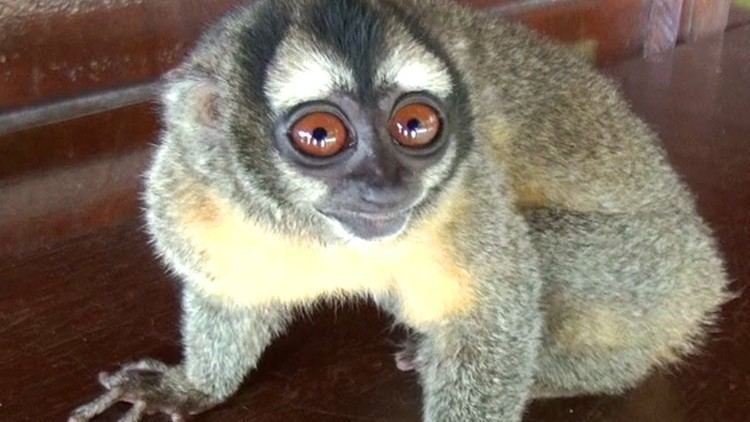Infraorder Simiiformes Scientific name Aotus Rank Genus | Phylum Chordata Suborder Haplorrhini Parvorder Platyrrhini Higher classification Aotidae | |
 | ||
Lower classifications Three‑striped night monkey, Black‑headed night monkey, Panamanian night monkey | ||
Night monkey
The night monkeys, also known as the owl monkeys or douroucoulis, are the members of the genus Aotus of New World monkeys (monotypic in family Aotidae). The only nocturnal monkeys, they are native to Panama and much of tropical South America. Night monkeys constitute one of the few monkey species that are affected by the often deadly human malaria protozoan Plasmodium falciparum, making them useful as non-human primate experimental models in malaria research.
Contents
- Night monkey
- Panamanian night monkey baby
- Taxonomy
- Classification
- Physical characteristics
- Ecology
- Behavior
- Conservation
- References

Panamanian night monkey baby
Taxonomy

Until 1983, all night monkeys were placed into only one (A. lemurimus) or two species (A. lemurinus and A. azarae). Chromosome variability showed that there was more than one species in the genus and Hershkovitz (1983) used morphological and karyological evidence to propose nine species, one of which is now recognised as a junior synonym. He split Aotus into two groups: a northern, gray-necked group (A. lemurinus, A. hershkovitzi, A. trivirgatus and A. vociferans) and a southern, red-necked group (A. miconax, A. nancymaae, A. nigriceps and A. azarae). Arguably, the taxa otherwise considered subspecies of A. lemurinus – brumbacki, griseimembra and zonalis – should be considered separate species, whereas A. hershkovitzi arguably is a junior synonym of A. lemurinus. A new species from the gray-necked group was recently described as A. jorgehernandezi. As is the case with some other splits in this genus, an essential part of the argument for recognizing this new species was differences in the chromosomes. Chromosome evidence has also been used as an argument for merging "species", as was the case for considering infulatus a subspecies of A. azarae rather than a separate species. Fossil species have (correctly or incorrectly) been assigned to this genus, but only extant species are listed below.
Classification
Family Aotidae

Physical characteristics

Night monkeys have large brown eyes; the size improves their nocturnal vision, thus increasing their ability to be active at night. They are sometimes said to lack a tapetum lucidum, the reflective layer behind the retina posessed by many nocturnal animals. Other sources say they have a tapetum lucidum composed of collagen fibrils. At any rate, night monkeys lack the tapetum lucidum composed of riboflavin crystals possessed by lemurs and other strepsirrhines, which is an indication that their nocturnalitiy is a secondary adaption evolved from ancestral diurnal primates.

Their ears are rather difficult to see; this is why their genus name, Aotus (meaning "earless") was chosen. There is little data on the weights of wild night monkeys. From the figures that have been collected, it appears that males and females are similar in weight; the heaviest species is Azara's night monkey at around 1,254 grams (2.765 lb), and the lightest is Brumback's night monkey, which weighs between 455 and 875 grams (1.003 and 1.929 lb). The male is slightly taller than the female, measuring 346 and 341 millimetres (13.6 and 13.4 in), respectively.
Ecology
Night monkeys can be found in Panama, Colombia, Ecuador, Peru, Brazil, Paraguay, Argentina, Bolivia, and Venezuela. The species that live at higher elevations tend to have thicker fur than the monkeys at sea level. The night monkey can live in forests undisturbed by humans (primary forest) as well as forests that are recovering from human logging efforts (secondary forest).
Behavior
The name "night monkey" comes from the fact that all species are active at night and are, in fact, the only truly nocturnal monkeys (an exception is the subspecies Aotus azarae azarae, which is cathemeral). Night monkeys make a notably wide variety of vocal sounds, with up to eight categories of distinct calls (gruff grunts, resonant grunts, sneeze grunts, screams, low trills, moans, gulps, and hoots), and a frequency range of 190-1,950 Hz. Unusual among the New World monkeys, they are monochromats, that is, they have no colour vision, presumably because it is of no advantage given their nocturnal habits. They have a better spatial resolution at low light levels than other primates, which contributes to their ability to capture insects and move at night. Night monkeys live in family groups consisting of a mated pair and their immature offspring. Family groups defend territories by vocal calls and scent marking.
The night monkey is socially monogamous, and all night monkeys form pair bonds. Only one infant is born each year. The male is the primary caregiver, and the mother only carries the infant for the first week or so of its life. This is believed to have developed because it increases the survival of the infant and reduces the metabolic costs on the female. Adults will occasionally be evicted from the group by same-sex individuals, either kin or outsiders.
Conservation
Most night monkey species are threatened by varying levels of habitat loss throughout their range, caused by agricultural expansion, cattle ranching, logging, armed conflict, and mining operations. They are also removed from wild for national and international trade. This trade is primarily for biomedical research and while much of it is legal, it is also continuing illegally from at least part of their range. To a lesser extent night monkeys are also sold as pets, as are all primate families found in South and Central America. All range countries of night monkeys have some legislation in place to protect this species though in many cases it is insufficient and enforcement is lacking.
